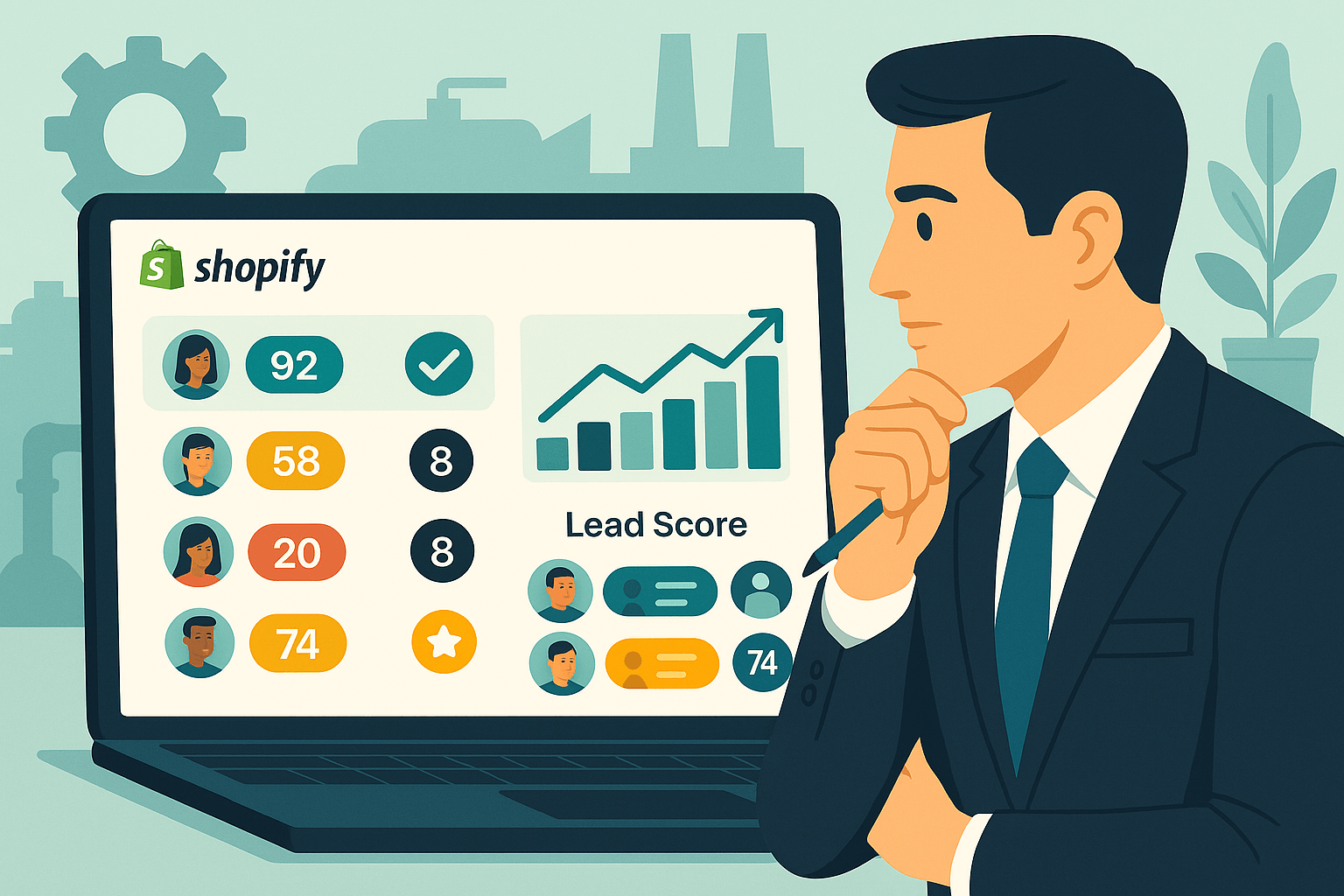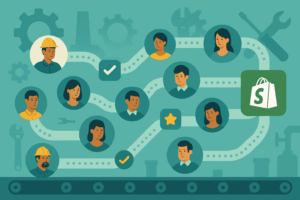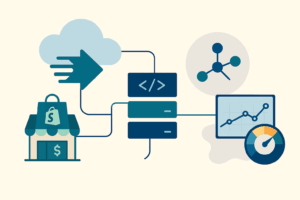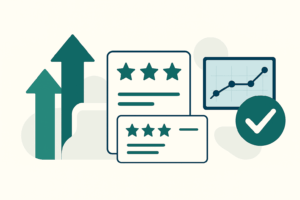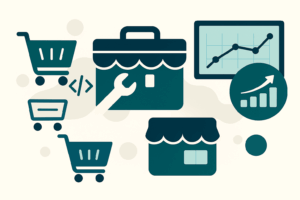The Problem No One Talks About in Industrial Sales
Every week, a familiar pattern repeats itself in industrial sales teams: new leads come in, and reps scatter. They call everyone. Email everyone. Some follow up five times, some once, and most at random.
The logic? “A lead is a lead.”
But anyone who’s sold high-ticket equipment knows that’s a lie.
Industrial equipment buyers don’t move fast. They rarely raise their hands. The decision isn’t made by one person, and it sure as hell isn’t made after downloading a brochure. So what happens? Sales teams chase cold leads while hot ones slip through unnoticed.
The cost of this is focus.
Not just wasted hours, but blown opportunities. You can’t prioritize real buyers if you can’t see who’s real.
And here’s the kicker: you already have the data. It’s sitting inside Shopify Plus. Who visited what product? Who opened which spec sheet? Who built a quote and came back twice in a week?
But no one’s using it, because most commerce platform setups—Shopify Plus included—weren’t built for this kind of intelligence.
So instead of working smarter, sales teams go wide. They chase everything. And they burn out.
Why Traditional Lead Scoring Doesn’t Work for Industrial Equipment
Most lead scoring systems were built for SaaS. Or retail. Or mid-ticket B2B, where the buying cycle is short, the stakeholders are obvious, and the decision fits neatly into a webinar follow-up or drip campaign.
That’s not industrial equipment.
You’re selling a $30,000 hydraulic press or a six-figure CNC retrofit, sometimes with custom install requirements, financing discussions, and engineering reviews that span 6 months or more.
But your CRM? It still gives a lead 50 points because they filled out a form and opened an email.
That’s not scoring. That’s spreadsheet math. And in this space, it’s worse than useless. It sends your team chasing noise.
Why It Fails:
- Form fills don’t reflect buying intent. A junior tech or intern might request a quote just to check a box. Meanwhile, a real buyer could be deep into your spec sheets and never fill out a thing.
- Most lead scoring ignores buying committees. Procurement might show up late in the process. Maintenance leads research first. Engineers evaluate specs. Scoring logic built around a single persona misses 70% of the buying motion.
- Behavioral data gets overlooked. If a lead spends 14 minutes zooming into a CAD file on your product page, that should trigger action. But most systems don’t even record it, let alone rank it.
- Sales teams don’t trust the score. Because they’ve been burned. The “hot” leads end up cold. The big logos go dark. The whole system gets ignored.
You need a new lens, one that understands how serious buyers behave long before they raise their hand.
Predictive scoring isn’t about who filled out the form first. It’s about who’s actually in motion.
What Predictive Lead Scoring Looks Like for Industrial Buyers in a Shopify-Based System
This isn’t about assigning arbitrary points. It’s about spotting signals in the noise, using real behavior to forecast real intent.
Because industrial buyers don’t follow a linear path. They poke around. They download specs. They disappear for weeks. Then, without warning, they come back and request a quote. If your system can’t anticipate that resurgence, you’re reacting too late.
Here’s What Matters:
- Page depth on key SKUs. Did they just glance at a product, or did they view it three times, scroll to the technical details, and open the PDF manual?
- CAD drawing engagement. If someone zooms, downloads, or shares a 3D model, that’s a buying signal, not a casual browse.
- Repeat visits across different devices or IPs. That’s likely a buying committee at work: engineers, operations, and procurement all reviewing the same equipment.
- Quote builder or configurator usage. These are high-friction tools. Anyone using them is deep in evaluation, not just browsing.
- Spec sheet downloads + time-on-page. Especially when combined with rapid revisit patterns (“They came back 3 times in 48 hours”).
- Geolocation and company match. When the data matches known targets or account lists, the score should jump fast.
It’s Not About More Data It’s Better Correlation
A good predictive scoring model doesn’t try to track everything. It tracks the right things and knows what those patterns mean for your buyers.
Example:
If someone viewed a forklift SKU for 90 seconds, that’s noise.
The same goes for used industrial equipment, buyers researching pre-owned machinery often demonstrate stronger intent through tool use and document engagement than through form fills.
But if they viewed three different forklifts, clicked the “compare” button, then downloaded a performance chart, now you’ve got a warm lead in motion.
That’s the moment sales should step in.
Not after a form.
Not after a call.
Right then in the right moment.
Before you can score behavior or automate intelligent handoffs, you need the right infrastructure.
If your e-commerce system can’t track buyer actions across SKUs, specs, and quote tools in real time, no amount of scoring logic will save you. That’s why getting your backend right, especially your ecommerce platform, is non-negotiable.
E-commerce platforms for industrial sales growth aren’t a nice-to-have. It’s the groundwork that makes predictive systems possible.
Architecting Your Shopify Plus Stack and Services for Predictive Scoring
Shopify Plus wasn’t built for predictive lead scoring, but that doesn’t mean it can’t be done. You just need to think like an architect, not a marketer.
Your data’s already there. It lives in pageviews, customer sessions, metafields, and behavioral triggers. The trick is stitching it together and piping it into systems that can make decisions with it.
Here’s how.
1. Start With Intent-Rich Behavior Tracking
Tools like Hotjar, Microsoft Clarity, or Smartlook can capture click paths, scroll depth, and user behavior, especially around complex assets like quote builders or CAD downloads.
These tools are best used for pattern discovery. To automate scoring or alerts, you’ll need to pair them with GA4 or a customer data platform.
Pair that with Shopify’s native analytics, GA4 event tagging, and your on-site search logs, and you’re already sitting on a goldmine of predictive input.
Watch for patterns like:
- Multiple visits to the same product within a short time window
- Behavior near high-value conversion points (e.g. shipping estimate tools, financing info)
- Downloads of gated technical documents
2. Enrich Your Lead Data
Every time a user fills out a contact form or quote request, enrich it automatically.
Use Clearbit, ZoomInfo, or Apollo to append:
- Company size
- Industry vertical
- Job title
- Technology stack
- Location proximity to your reps or fulfillment zones
This adds weight to your score. A maintenance director at a 100-location logistics firm should be treated differently from a junior engineer at a 10-person machine shop.
3. Store and Score Profiles
Shopify Plus can’t natively run predictive models, but you can use:
- Shopify Flow to trigger workflows based on user behavior. Flow triggers are event-based. For scoring thresholds, store values in metafields or push logic into Klaviyo or your CRM.
- Metafields to store lead score attributes and behavioral flags
- Klaviyo (for marketing-qualified leads) or a CDP like Segment to manage profiles and run model logic
- Or push enriched behavioral data directly into a CRM like HubSpot or Salesforce for score-triggered tasks
You’re not just building a report, you’re building an intelligent system that:
- Monitors buyer behavior
- Assigns contextual weight
- Sends reps a signal when it matters
4. Automate the Hand-Off
Once a lead crosses a scoring threshold (say, “engaged with 3+ SKUs, downloaded spec, visited quote tool”):
- Trigger a task in your CRM
- Alert the assigned sales rep with behavioral notes
- Push the lead into a different nurture path if not ready (e.g., “Quote Configurator Users” email series)
- Or even fire a Slack or SMS notification if it’s a strategic account
This isn’t about cobbling together duct tape automations. It’s about architecting a system that listens to what your buyers are already telling you, through their behavior, and acting before they go cold.
Getting Sales Aligned Around High-Intent Activity
A predictive scoring system is useless if sales don’t use it. And they won’t, unless it gives them two things: clarity and confidence.
Sales reps don’t want more leads. They want better leads. Leads that come with context. Leads that show up warm and relevant, not cold and confusing.
You want your sales team to stop thinking like hunters and start acting like closers.
Here’s how you do that:
Show, Don’t Tell
Instead of saying “this lead scored 87,” show them:
- “This buyer viewed 4 industrial baler SKUs.”
- “Spent 8 minutes on the specs page.”
- “Downloaded two CAD files.”
- “Revisited the quote builder twice in 48 hours.”
Now the score has teeth. The rep understands why this contact matters.
Only Alert When the Timing Is Right
Don’t ping your team every time someone opens an email. That’s noise.
Instead, trigger alerts when multiple high-value behaviors stack up, like:
- Time on page + spec download + revisit within 3 days
- Quote builder used + enriched company info shows 200+ employees
- Viewed the install guide before filling out a quote request
These combos tell the rep: “This isn’t just interest—it’s momentum.”
Route by Specialty or Region
Push scored leads to the right rep based on:
- Product category
- Territory
- Company size
- Application type
This cuts down handoffs and gives the buyer a better experience. It also helps reps specialize—because when you sell $40K gear, context matters.
Keep Low Scores in Nurture
Don’t waste rep time on tire-kickers.
Let low-scoring leads enter a Klaviyo Email nurture flow instead:
- Case studies
- Equipment ROI calculators
- Application-based walkthroughs
- Spec sheet highlights
As they engage more, their score rises, and then they get routed to sales.
When sales know that every lead in their inbox has real potential, they show up faster. Sharper. More prepared. You don’t need more calls—you need better ones.
What Changes When You Score Properly
Everything. Not overnight, but fast enough that your sales team will stop asking if the system works and start asking how soon they can get more leads like these.
Predictive scoring doesn’t just filter leads—it delivers real business benefits by reshaping your entire sales rhythm.
Sales Teams Stop Guessing
Instead of waking up to a long list of cold contacts, reps start each day with a short list of high-intent leads, backed by behavior, not assumptions.
Now they know:
- Who to call first
- What product does the lead care about
- What materials has the lead already seen
- How deep into the buying cycle that lead might be
That’s not just productivity. That’s confidence. And confidence closes.
Marketing Gets Smarter, Too
Once you see which behaviors lead to real deals, you can:
- Stop wasting ad spend on vanity traffic
- Stop optimizing for surface metrics like “quote requests.”
- Start building content that aligns with real buyer motion
(like comparison sheets, installation videos, or downloadable spec packs) - And stop promoting low-interest SKUs just because they’re overstocked—let buyer behavior, not inventory stock, shape your funnel.
But predictive scoring only works if you’re attracting the right traffic in the first place. If your SEO, content, and paid strategy aren’t bringing in serious industrial buyers, even the best scoring model won’t save you. You also need to know how to build visibility with high-intent prospects from the start.
You’re no longer generating random MQLs. You’re feeding a machine that scores, learns, and sharpens.
Follow-Up Becomes a Competitive Advantage
Most industrial suppliers follow up late or blandly.
But with scoring in place, your follow-up sounds like this:
“Hey John, I saw you were looking at the 5-ton hydraulic model yesterday, and downloaded the PSI tolerance sheet. We’ve helped a few distribution centers like yours spec out that exact unit for elevated load requirements. Want to hop on a 15-minute call and walk through fit?”
That’s not spam. That’s relevant. That’s what moves deals forward.
Forecasting Gets More Real
Over time, you’ll start to notice patterns in your top scores:
- How many touches does it take
- What behavioral combos predict a close
- Which industries are actually converting, not just shopping
Now your revenue forecast isn’t just a finger in the wind. It’s a pattern match.
Most people treat lead scoring like a checkbox. But when you build it right, it becomes the backbone of your entire revenue motion.
What’s Holding Most Manufacturers Back
It’s not the tech.
It’s not the data.
It’s the story they keep telling themselves.
We’ve heard it a hundred times:
“Our deals are too complex for automation.”
“Our customers don’t want to be tracked.”
“We know how to spot a real buyer when we talk to them.”
Here’s the truth:
Your customers don’t care how your sales team feels.
They care about speed, relevance, and confidence.
If they have to wait two days to hear from you—or get a generic follow-up email—they’re gone.
Myth #1: “Our Sales Cycle Is Too Custom for Predictive Scoring”
No, it’s not.
Even custom deals follow patterns: engineers research specs, procurement checks budget, and operations confirm fit. That motion might take 90 days, but the early digital behaviors are the same every time.
Predictive scoring doesn’t eliminate complexity. It helps you spot it earlier.
Myth #2: “We Don’t Want to Over-Automate”
Great. Don’t.
Predictive scoring isn’t about removing humans, it’s about augmenting them.
You’re not replacing sales. You’re just telling them where to show up.
Think of it like radar. Planes still have pilots. But would you fly without one?
Myth #3: “We Don’t Have Enough Data”
If you’re on Shopify Plus, you already have behavioral data.
If you’re using Klaviyo, GA4, or Smartlook, you’ve got more.
The problem isn’t the data. It’s that no one’s modeling the meaning behind it.
You don’t need AI. You need clarity.
Start with what you’ve got.
Then let the system get smarter over time.
The companies that win the next decade of industrial sales aren’t the ones with the biggest catalogs or the flashiest CRMs.
They’re the ones who stop guessing and start listening—quietly, consistently—to what the buyer is already telling them.
Start Simple: The Minimum Predictive Model That Works
You don’t need machine learning. You don’t need a PhD. You don’t need six months of back-end dev work.
What you need is a system that can answer one question:
“Is this lead behaving like someone who’s going to buy?”
That’s it.
So start simple. Build a model that reflects real business behavior—three to five clear actions that signal deal momentum and trigger action.
Your First Predictive Score Might Look Like This:
- +10 points for visiting a product page
- +20 for downloading a spec sheet or CAD file
- +15 for using the quote builder or configurator
- +25 if they revisit within 48 hours
- +30 if their email matches a target account domain (via enrichment)
Threshold: 75 points = sales notified
Now you’ve got a scoring engine.
It’s not perfect. But it’s directional—and it’s actionable.
Don’t Wait for “Perfect”
The danger isn’t scoring wrong.
The danger is scoring nothing and treating every lead like it’s the same.
Launch the model. Watch what happens. Tighten it weekly.
Most manufacturers wait until they’ve built the perfect workflow, with every tool connected and every variable defined. Meanwhile, they’re losing deals to competitors who just showed up sooner.
Use the Tools You Already Have
If you’re on Shopify Plus, you can:
- Use Shopify Flow to flag and tag user behavior
- Store score data in customer metafields
- Enrich lead data via Zapier or a Clearbit API call
- Trigger alerts or workflows in HubSpot, Salesforce, or even Slack
- Use Klaviyo to drop high-scorers into a rep-assigned nurture sequence powered by real-time behavior.
You don’t need a Frankenstein setup, but you do need smart wiring. A few good signals, stored properly and routed intelligently, make all the difference.
This isn’t about scoring for scoring’s sake. It’s about giving your reps a reason to pick up the phone with confidence.
If You Only Do One Thing, Do This
Forget the dashboards. Forget the AI hype. Forget the 147-point lead score template you downloaded from some marketing automation blog. If you only do one thing, start paying attention to buyer motion.
Not form fills. Not open rates. Not job titles. Motion.
In industrial sales, your buyer rarely waves a flag and says, “Hey, I’m ready.” They observe. They compare. They dig into CAD drawings, download the spec sheet, and forward it to an ops lead. They revisit a product page at 9:47 p.m. on their iPad after a shift. They don’t always raise their hand, but their behavior is screaming.
That’s the moment. In today’s world of long buying cycles and complex deals, catching that window is the difference between winning and being forgotten.
So if you’re overwhelmed by complexity or tech paralysis, don’t be. Here’s where to start: pull your last ten closed deals. Look backward. Study what each buyer did in the weeks before they talked to sales. Which pages did they visit? What documents did they download? How many times did they return? That’s your initial scoring model—not theory, not hope, but observed behavior that led to revenue.
Once you’ve got that, wire it in. Tag those behaviors inside Shopify Plus. Track the revisit timing. Use Shopify Flow, metafields, or even Klaviyo to assign weight. Push a task to the CRM. Notify the rep. Build a nurture trigger. It doesn’t need to be perfect. It just needs to run.
Because at the end of the day, this isn’t about building a lead scoring system. It’s about shifting how you see the buyer. From static profiles to living motion. From waiting to be contacted to stepping in at the right moment, when they’re already halfway sold and just need a confident guide to close the loop.
That’s how you stop wasting time. That’s how you build a pipeline with teeth. And that’s how you make Shopify Plus work like a predictive revenue engine—not just a checkout platform.
Predictive Sales Toolkit for Shopify Plus
Score Industrial Leads Before Your Competitors Call Them
Minimum Viable Predictive Scoring Model (MVP-SM)
Objective: Score lead behavior using simple, high-signal actions in your Shopify Plus environment.
| Action Tracked | Score |
| Viewed a product page | +10 |
| Downloaded a spec sheet or CAD file | +20 |
| Used quote builder or configurator | +15 |
| Revisited product page within 48 hours | +25 |
| Matched target account domain (via enrichment) | +30 |
Trigger Threshold:
75 points = Notify sales
Use Shopify Flow + metafields to store score. Push alerts to CRM or Slack once threshold is hit.
Shopify Plus Infrastructure Checklist
Track the right behavior. Connect the right dots. No code degree required.
| Tool or Feature | Purpose | Connected To |
| Shopify Flow | Trigger workflows from behavior | Lead alerts, CRM tasks |
| Shopify Metafields | Store behavior scores + flags | Enriched profiles, Klaviyo segments |
| GA4 (Google Analytics) | Capture events: downloads, page depth | Behavior-based scoring |
| Klaviyo | Email nurture for low- or mid-score | Sales-ready alerts, behavioral series |
| Hotjar / Smartlook | See patterns: scrolls, quote tool use | Pattern discovery |
| Clearbit / ZoomInfo | Append firmographics to form fills | Score weight & rep assignment |
Enrichment Stack Setup (Simple Mode)
Want sales to focus on real buyers? Add context to every lead.
Use Zapier or webhook integrations to add:
- Company size
- Industry
- Location proximity to rep
- Tech stack (if relevant)
- Known account match
Recommended Tools:
- Clearbit API
- ZoomInfo FormComplete
- Apollo Enrichment API
Trigger enrichment post-form submission → update score → route.
Smart Nurture Entry Triggers
Low score ≠ no score. Don’t ghost them.
Use Klaviyo to push leads under the threshold into auto-nurture.
Trigger Examples:
| Behavior | Nurture Sequence |
| Viewed 2+ product pages | Product overview + ROI calculator |
| Downloaded 1 spec sheet | Application use case email series |
| Quote builder used but no submit | “Still configuring?” value-first follow-up |
Let behavior shape the nurture. Then re-score every interaction.
Motion Always Wins
If you’re still waiting for the perfect lead to fill out a form, you’ve already missed the moment.
Real buyers don’t announce themselves—they move quietly. They compare specs at 10 p.m., revisit product pages twice in 48 hours, forward CAD files to ops. If your system isn’t tracking that motion, you’re not selling—you’re guessing.
Predictive lead scoring isn’t a tool. It’s an advantage. One that helps your reps stop chasing and start closing.
You don’t need more leads. You need to know which ones matter—and when to act.
If you’re ready to build that system, we’ll help you wire it.
Let’s stop chasing. Let’s start closing.
Contact us to wire a system that listens.



